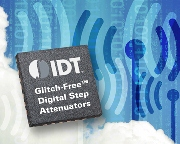 Integrated Device Technology (IDT) has developed a new digital step attenuator (DSA) that reduces transient “glitches” during most significant bit (MSB) transitions by up to 95 percent in multi-standard 4G, 3G, and 2G cellular base station and industrial applications. This ‘Glitch-Free’ DSA enables customers to simplify their software interface, improve reliability, and prevent damage to expensive sub-assemblies such as power amplifiers.
Integrated Device Technology (IDT) has developed a new digital step attenuator (DSA) that reduces transient “glitches” during most significant bit (MSB) transitions by up to 95 percent in multi-standard 4G, 3G, and 2G cellular base station and industrial applications. This ‘Glitch-Free’ DSA enables customers to simplify their software interface, improve reliability, and prevent damage to expensive sub-assemblies such as power amplifiers.
The IDT F1950 and F1951 are digital step attenuators have been designed to meet the requirements of base transceiver station (BTS) receive, transmit, and digital pre-distortion (DPD) paths. The technology eliminates attenuation setting overshoot (glitches) from the transmit and receive paths of cellular communication systems, while at the same time reducing insertion loss and improving distortion performance. This helps to simplify the hardware and software interfaces within the BTS, reducing cost and lowering overhead. The extremely low IM3 distortion improves DPD path performance, enabling better transmitter spectral mask compliance and lower power consumption.
“IDT’s new DSAs are another key building block of the communications signal chain that our customers are demanding,” said Tom Sparkman, vice president and general manager of the Communications Division at IDT. “Competing DSAs can glitch up to 10 dB during transitions of the MSB, while IDT’s Glitch-Free DSAs limit glitches to less than 0.5 dB – a significant performance advantage for our customers. In addition, our large attenuation range and high resolution gives customers the flexibility needed to service all the most popular wireless platforms.”
The IDT F1950 and F1951 operate from 100 MHz to 4000 MHz, and can communicate via a parallel or serial interface. The devices are ideal for setting the power level in 4G long-term evolution (LTE), time-division duplexing (TDD), wideband code division multiple access (WCDMA), extended global system for mobile communications (EGSM) and other popular systems. The DSAs feature very low insertion loss (< 1.3 dB at 2 GHz) and are extremely accurate (< 0.2 dB over temperature), allowing for improved sensitivity and signal-to-noise ratio (SNR) in the receiver path.
 CIE Components in Electronics
CIE Components in Electronics



